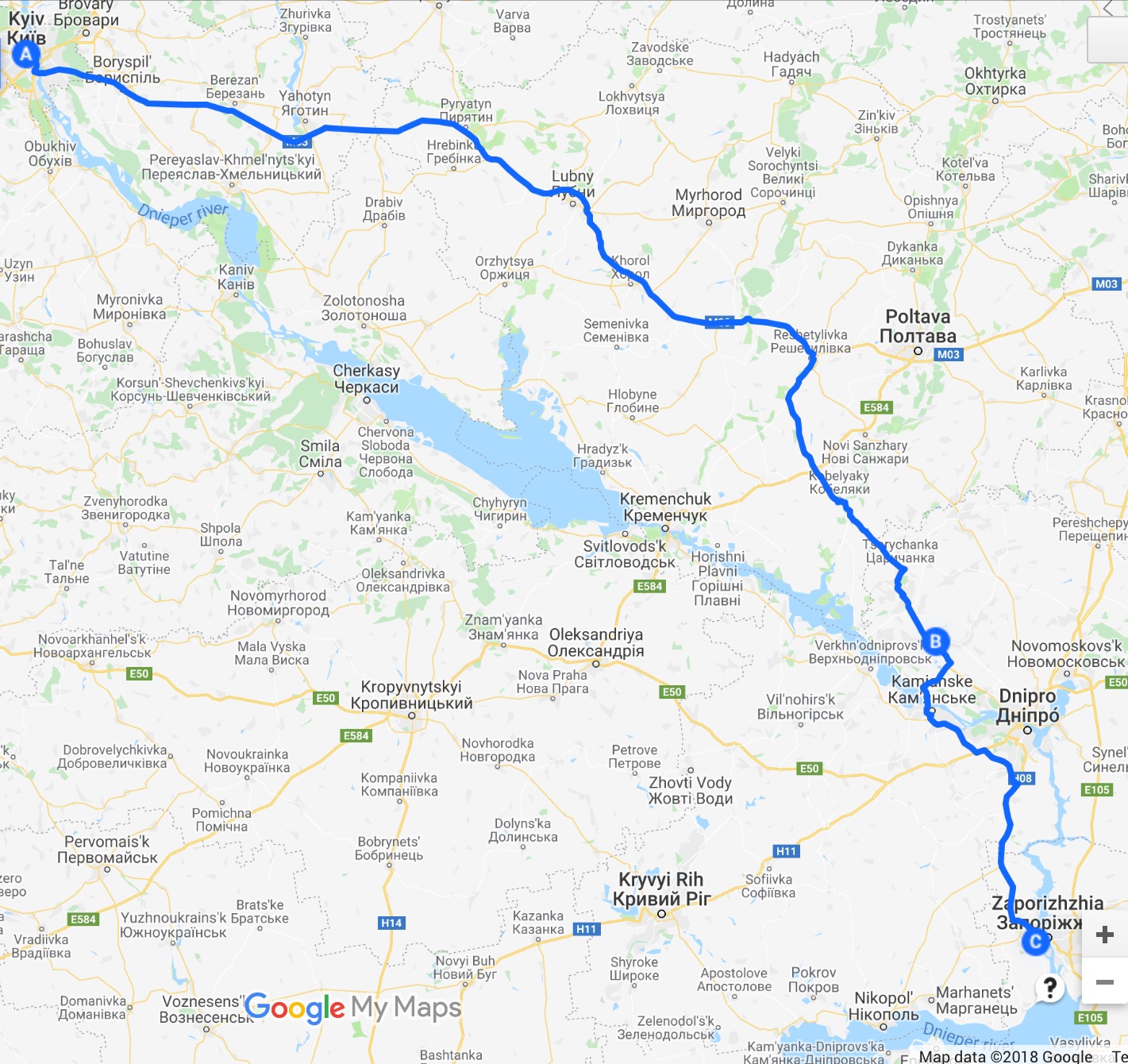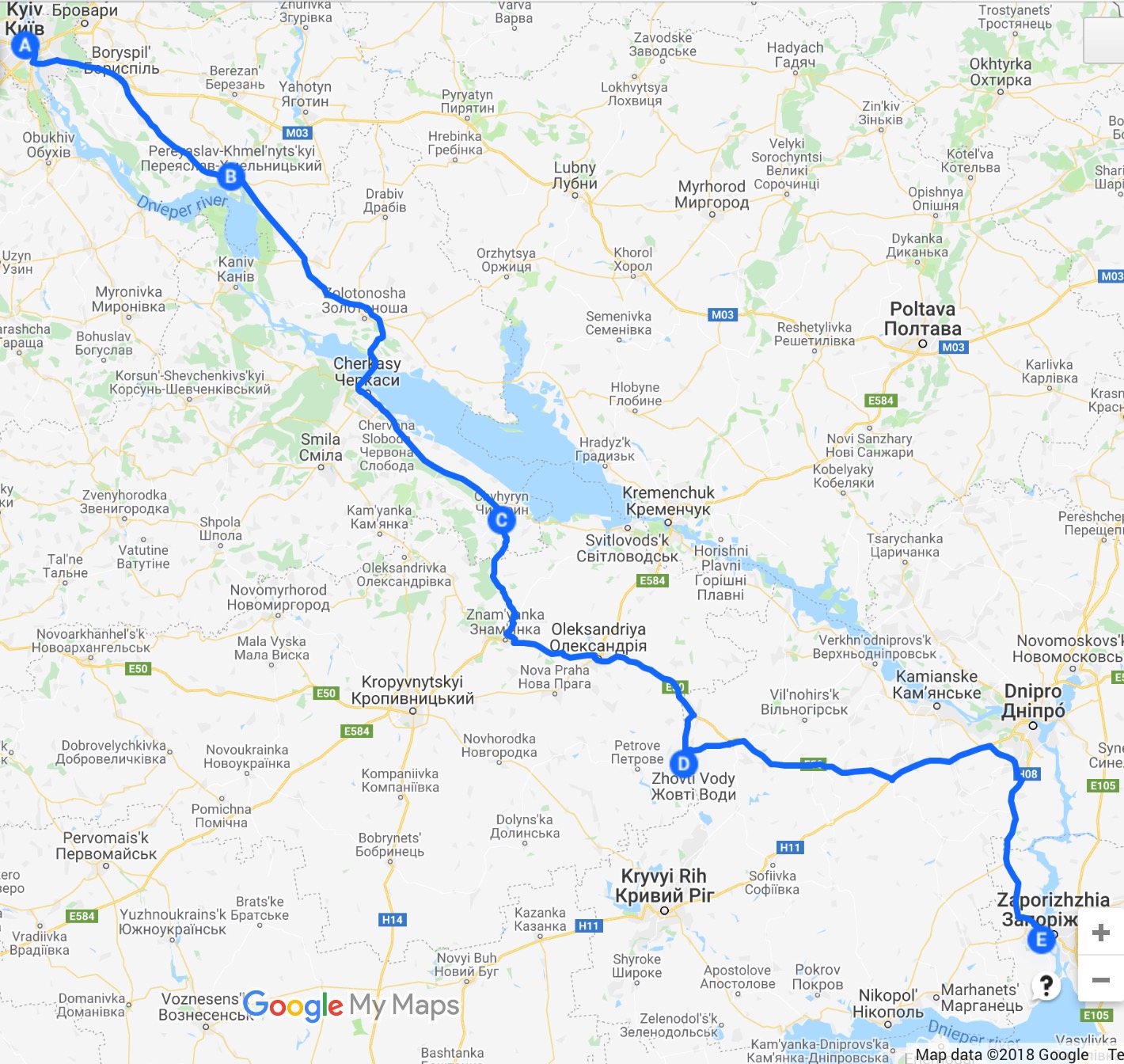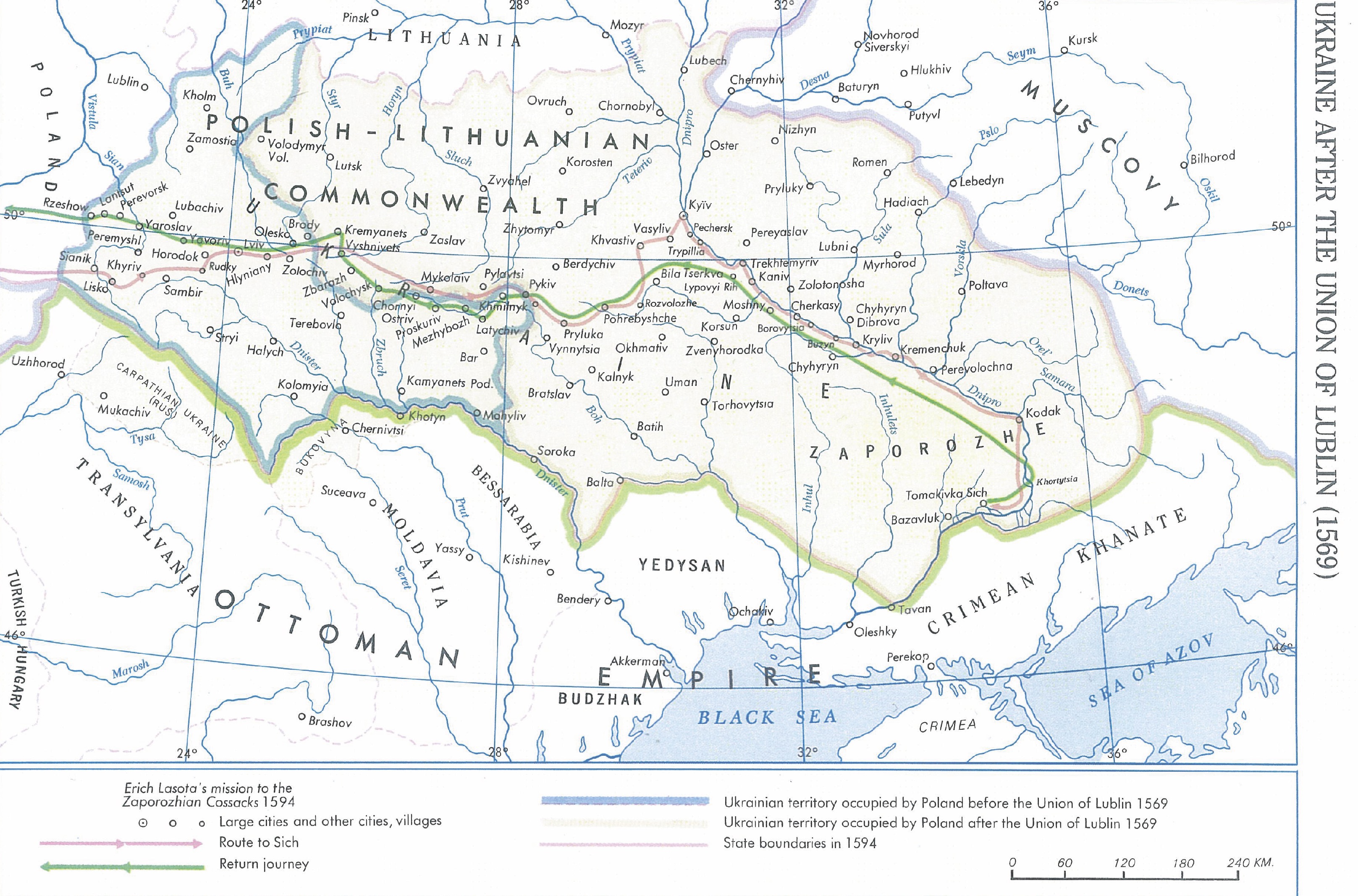Duration from Kyiv to Zaporizhia by train - 7,5 - 12,5 hours.
Variants of routes from Kyiv to Khortytsia (Zaporizhia) by car:
1) 570 km
Kyiv - Petrykivka - Khortytsia (Zaporizhia)
2) 610 km
Kyiv - Pereiaslav-Khmelnytskyi - Chygyryn - Zhovti Vody - Khortytsia (Zaporizhia)
3) 610 km
Kyiv - Pereiaslav-Khmelnytskyi - Kaniv - Chygyryn - Khortytsia (Zaporizhia)
3) 625 km
Kyiv - Poltava - Khortytsia (Zaporizhia)
The first written source, in which the island is mentioned under the name of Grygori, is the book «An Account of the Condition of the Empire» (946—953 A. D.) by the Roman Emperor Constantine VII (Born in the Purple). Later it became known that the Island of Khortitsa had been visited by Kievan princes Askold and Dir, Oleg, Igor; up till now there exists a legend that it was here, at the Dnieper rapids, that in the fight against the Pechenegs in 972 the Kiev Prince Svyatoslav was slain.
Khortitsa is also mentioned in Ancient Eastern Slavic chronicles, particularly in 1103 A. D. saying that the army of Grand Prince Svyatopolk Izyaslavovich had camped here. Prior to the battle on the Kalka River in 1223 the Eastern Slavs armed forces had also gathered here.
Erich Lasotas' mission to the Zaporozhian Cossacks, 1594
The Khortytsia Island is also related to the origin and formation of the Zaporozhian Cossacks — an unordinary occurrence in the history of not only the Ukrainian people, but that in our whole country. The Cossacks had been on the island many times. It was here that they left the fortifications used for the defense of the Kievan Rus state borders from the raids of Turks and Tatars. From this area the Cossack forces under Bogdan Khmelnytsky in 1648 launched their struggle against the Polish-Lithuanian oppressors, which ended in the reunion of the Ukraine with Russia.
The banks, cliffs and the flooded meadows on the Khortytsia Island were not evaded in the Russo-Turkish War of 1735—1739. Under the leadership of the well-known Russian naval commander — Vice-Admiral N. Senyavin a dock-yard was built on the island. Russian masters with the Cossacks launched a whole flotilla from here. In the battles on the Black Sea it played a significant role.
The Island of Khortitsa has been visited by prominent Ukrainian and Russian figures of culture: Taras Shevchenko, Mykola Lysenko, Ilya Repin, Valentin Serov, Maxim Gorky, Ivan Bunin. The whole history of the island is on display in the Zaporizzya History Museum opened on Khortitsa in October 1983.
The history is only one aspect, making the largest island on the Dnieper unique. The other feature is the inimitable natural environment on the island. Only in the recent decades it has become known that here in miniature represented are practically all the landscape zones of the Ukraine: forest-steppe, steppe, forest, hills, meadows and flooded woods. While in the northern part of the island, the culturally developed part, one can hear the sounds of Young Pioneer detachments' bugles, in the southern part wild elks are wandering; while groups of tourists are walking through the halls of the museum in the northern part, in the southern white, grey and red herons fly up out of the emerald reeds; in the northern buses and trolleybuses run along the asphalted roads, in the southern wild boars are resting in the thickets of false indigo. All this is concentrated on a single plot of land, which, by the way, is a district of a city, not of any kind, but of a large industrial centre— Zaporizzhya.
Khortitsa is open to anyone at any time of the day. Prohibited is only the entrance to the flooded land in the southern part (occupying about '/s of the whole territory) because of its particular uniqueness and vulnerability. The community of the town has accepted this decision with satisfaction because the flooded ground of Khortytsia is one of the last breeding sites of intact nature in the European part of the country. Here, on the territory of several hundred hectares, about 150 species of birds come to nest, there is a multitude of plants growing here, most of them are recorded in the Ukraine Red Book. For example, the water-chestnut. This plant is of the same age as the dinosaurs, which are known to have become extinct ages and ages ago, but the water-chestnut has survived unchanged ever since. It is endemic, like the pasque-flower, sword-flower, Savrainian onion and the Dnieper knapweed found here.
Zaporozhian Sich (1550-1775)
 Towards the end of the XV century the first references to Cossacks (Kozaks) on the Ukrainian frontier appear. "Kozak" is a Turkic word meaning "free, independent person", as opposed to a serf, who was bound to a master. The word referred to men engaged in warfare and robbery and, in the mind of the people, developed in a manner parallel to the English Robin Hood, across a spectrum of meanings: handsone, bold, young, knightly, defender of the fatherland. This new class of Cossacks drew its members from runaway serfs. Organized along democratic principles into small, tight-knit groups to defend
Towards the end of the XV century the first references to Cossacks (Kozaks) on the Ukrainian frontier appear. "Kozak" is a Turkic word meaning "free, independent person", as opposed to a serf, who was bound to a master. The word referred to men engaged in warfare and robbery and, in the mind of the people, developed in a manner parallel to the English Robin Hood, across a spectrum of meanings: handsone, bold, young, knightly, defender of the fatherland. This new class of Cossacks drew its members from runaway serfs. Organized along democratic principles into small, tight-knit groups to defend
themselves against Tatar bands and for cooperation in hun ting and fishing expeditions, the Cossacks moved into the steppes south of the lower tributaries of the Dnipro rapids-the prairie area known as "Wild Fields." Their elected leader was known by the Tatar titles, "hetman" or "otaman."
One of the first to organize the Cossacks was Ostap Dashkevych (1515-1535), the elder (starosta) of the port town of Cherkasy on the Dnipro River. Learning the Tatar methods of warfare, he operated along the Ukrainian-Tatar border. Dashkevych and his Cossack band raided in the Crimea and, in 1532, he distinguished himself in a victory over the Tatars in defense of the city of Cherkasy.
Cossack Prince Dmytro Bayda Vyshnevetskyi was the first to build, about 1550, a Cossack fortress, called in Ukrainian Sich. This was on the island of Little Khortytsia, whose steep banks rendered it eminently defensible. It was located downstream of the Dnipro rapids and as river rapids in Ukrainian are termed porohy, porih in Ukrainian - the region beyond the rapids is termed with the prepositional phrase za porohamy and the parasynthetic substantive zaporozhe. Hence we have the name of the area proverbial in Ukrainian history, the Zaporozhian Sich, the fort "beyond the rapids."
Later in 1558 the Little Khortytsia Sich was destroyed by the Tatars. Captured by the Turks in a struggle for the throne of Moldavia 1563 "Bayda" Vyshnevetskyi met a hero's death and has been immortalized in national song.
After the death of Vyshnevetskyi, the Cossacks, around 1564, located their Sich on the island of Tomakivka. In 1593, during the absence from the island of the majority of the Cossack forces, the Tatars destroyed the Sich at Tomakivka. In the same year, the Cossacks relocated their fort to the island of Bazavluk and from there, in 1628, to Mykytyn Rih (Mykyta's Corner).
About 1646 the Zaporozhian Cossacks established their Sich on the Chortomlyk River. From the Chortomlyk Sich, known as "Stara Sich" ("old fort"), a major offensive against Poland was launched in 1648 by Hetman Bohdan Khmelnytskyi, who emerged victorious and established an independent Ukrainian Cossack state This Sich was destroyed by the Muscovites after the battle of Poltava, which brought an end to Swedish expansion to the East.
Ukrainian Cossack state of Hetman Bohdan Khmelnytskyi (1648-1657):
March of Zaporizhian Cossacks:
Kiev & Ukraine Private Tour Guides
Kovbasa (sausage)
 Sausages were made in large quantities after a pig or a hog had been slaughtered. Thin intestines were washed thoroughly, then soaked for a while and scraped carefully from in and outside. Then they were stuffed with raw meat mixed with smashed garlic and seasoned with salt and pepper. Rolled in circles, sausages were either fried on both sides in a skillet or smoked in an oven. To extend the expiration date, sausages were coated with melted grease, put in pots or heatproof bowls and preserved in a cool place. Sausages were browned and served hot with stewed cabbage, vereschaka (stewed meat), or potatoes on the side.
Sausages were made in large quantities after a pig or a hog had been slaughtered. Thin intestines were washed thoroughly, then soaked for a while and scraped carefully from in and outside. Then they were stuffed with raw meat mixed with smashed garlic and seasoned with salt and pepper. Rolled in circles, sausages were either fried on both sides in a skillet or smoked in an oven. To extend the expiration date, sausages were coated with melted grease, put in pots or heatproof bowls and preserved in a cool place. Sausages were browned and served hot with stewed cabbage, vereschaka (stewed meat), or potatoes on the side.
In western regions (up to the Podillya region), sausages were not only fried but also smoked in ovens or specially dequipped stoves. The firewood burned in the oven that day did not contain any resinous types of wood.








